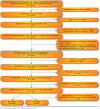Antipsychotic Adherence and Rehospitalization in Schizophrenia Patients Receiving Oral Versus Long-Acting Injectable Antipsychotics Following Hospital Discharge
- PMID: 26308223
- PMCID: PMC10398026
- DOI: 10.18553/jmcp.2015.21.9.754
Antipsychotic Adherence and Rehospitalization in Schizophrenia Patients Receiving Oral Versus Long-Acting Injectable Antipsychotics Following Hospital Discharge
Abstract
Background: Antipsychotic medications are a central component of effective treatment for schizophrenia, but nonadherence is a significant problem for the majority of patients. Long-acting injectable (LAI) antipsychotic medications are a recommended treatment option for nonadherent patients, but evidence regarding their potential advantages has been mixed. Observational data on newer, second-generation LAI antipsychotic medications have been limited given their more recent regulatory approval and availability.
Objective: To examine antipsychotic medication nonadherence, discontinuation, and rehospitalization outcomes in Medicaid patients receiving oral versus LAI antipsychotic medications in the 6 months after a schizophrenia-related hospitalization.
Methods: The 2010-2013 Truven Health Analytics MarketScan Medicaid research claims database was used to identify adult patients with a recent history of nonadherence (prior 6 months) who received an oral or LAI antipsychotic medication within 30 days after an index schizophrenia-related hospitalization. Primary outcome measures were nonadherence (proportion of days covered less than 0.80), discontinuation (continuous medication gap ≥ 60 days), and schizophrenia-related rehospitalization, all in the 6 months after discharge. Descriptive analyses compared users of oral versus LAI antipsychotic medication on sociodemographic, clinical, and treatment characteristics. Logistic regressions were used to examine associations between use of oral versus LAI antipsychotics and each study outcome while controlling for observed differences in sample characteristics. All outcomes were compared at 3 levels of analysis: overall LAI class, LAI antipsychotic generation (first-generation [FGA] or second-generation [SGA] antipsychotics), and individual LAI agent (fluphenazine decanoate, haloperidol decanoate, risperidone LAI, and paliperidone palmitate).
Results: Of the final sample, 91% (n = 3,428) received oral antipsychotics, and 9.0% (n = 340) received LAI antipsychotics after discharge. Slightly over half (n =183, 53.8%) of LAI users used an SGA LAI. A smaller percentage of patients receiving LAIs were nonadherent (51.8% vs. 67.7%, P less than 0.001); had a 60-day continuous gap in medication (23.8% vs. 39.4%, P less than 0.001); and were rehospitalized for schizophrenia (19.1% vs. 25.3%, P = 0.01) compared with patients receiving oral medications. The size of these differences was magnified when comparing SGA LAI users with users of oral antipsychotics for nonadherence. After controlling for all differences in measured covariates, LAI initiators had lower odds of being nonadherent (adjusted odds ratio [AOR] = 0.35, 95% CI = 0.27-0.46, P less than 0.001) and of having continuous 60-day gaps (AOR = 0.45, 95% CI = 0.34-0.60, P less than 0.001) when compared with patients receiving oral medications. Both FGA and SGA LAI users had lower odds of nonadherence compared with patients receiving oral antipsychotics. Similarly, FGA LAI users (AOR = 0.58, 95% CI = 0.40-0.85, P = 0.005) and SGA LAI initiators (AOR = 0.34, 95% CI =0.23-0.51, P less than 0.001) had lower odds of a 60-day continuous gap compared with patients receiving oral antipsychotics. Compared with those receiving oral antipsychotics, LAI initiators also had lower odds of rehospitalization (AOR = 0.73, 95% CI = 0.54-0.99, P = 0.041); however, when examined separately, only patients receiving SGA LAIs (AOR = 0.59, 95% CI = 0.38-0.90, P = 0.015) and not FGA LAIs (AOR = 0.90, 95% CI = 0.60-1.34, P = 0.599) had a statistically significant reduction in odds of rehospitalization. Among individual LAIs, odds of rehospitalization only among initiators of paliperidone palmitate were statistically different from those among users of oral antipsychotics (AOR = 0.53, 95% CI = 0.30-0.94, P = 0.031). While odds of rehospitalization were 33% lower among patients receiving risperidone LAI compared with those receiving oral antipsychotics, the estimate did not reach statistical significance (AOR = 0.67, 95% CI = 0.37-1.22, P = 0.194).
Conclusions: This claims-based analysis of posthospitalization adherence and rehospitalization outcomes in Medicaid patients with schizophrenia adds to the growing real-world evidence base of the benefits of LAI antipsychotic medications in routine clinical practice, particularly with regard to second-generation LAIs. As new SGA formulations become available for long-acting use, real-world studies with larger sample sizes will be needed to further delineate their potential advantages in terms of clinical outcomes and costs.
Conflict of interest statement
This study was funded by Alkermes, Inc. Marcus, Pettit, and Doshi report serving as consultants to Alkermes. Stoddard and Zummo are employees of Alkermes.
Study concept and design were contributed by Marcus, Doshi, Zummo, and Stoddard. Data collection was carried out by Zummo, Stoddard, and Marcus, and data interpretation was performed by Marcus, Doshi, Pettit, Zummo, and Stoddard. The manuscript was written by Marcus, Doshi, and Pettit, with assistance from Zummo and Stoddard, and revised by Zummo, Stoddard, and Pettit, along with Marcus and Doshi.
Figures
References
-
- Simpson GM. Atypical antipsychotics and the burden of disease. Am J Manag Care.2005;11(8 Suppl):S235-41. Available at: http://www.ajmc.com/publications/supplement/2005/2005-09-vol11-n8Suppl/S.... Accessed July 16, 2015. - PubMed
-
- Rice DP. The economic impact of schizophrenia. J Clin Psychiatry. 1999; 60(Suppl 1): 4-6. - PubMed
-
- Wu EQ, Birnbaum HG, Shi L, et al. . . The economic burden of schizophrenia in the United States in 2002. J Clin Psychiatry. 2005; 66(9): 1122-29. - PubMed
-
- Olfson M, Mechanic D, Hansell S, Boyer CA, Walkup J, Weiden PJ.. Predicting medication noncompliance after hospital discharge among patients with schizophrenia. Psychiatr Serv. 2000; 51(2): 216-22. - PubMed
-
- Lehman AF, Lieberman JA, Dixon LB, et al. . . Practice guideline for the treatment of patients with schizophrenia, second edition. Am J Psychiatry. 2004; 161(2 Suppl): 1-56. - PubMed
Publication types
MeSH terms
Substances
LinkOut - more resources
Full Text Sources
Other Literature Sources
Medical
Research Materials
Miscellaneous



